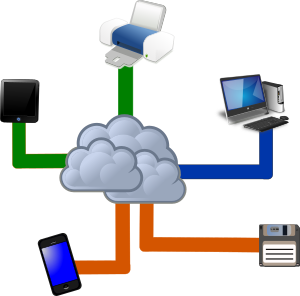The way business is done today is completely different from the traditional ways. The digital era, computers to be specific, have revolutionized day-to-day business transactions. Just the other day, having the Fax machine and Personal Computer (PC) were considered a cutting edge. Today, go to every corner in the business world and you’ll find these tools used in communication and other transactions, hence leaving us with the need to discuss five of the latest advances in business technology your business should have.

Cloud Computing
Cloud computing simply involves computing over the same network, with an application that runs on more than one connected work stations at the same time. This is made possible by server connected through a communication channel such as LAN – local area network, WAN – wide area network, intranet or the internet. Having software that works online will ensure that the application can be accessed from anywhere and also increases computer processing power. Cloud computing may also be offered in a private, public or hybrid network.
Computer Aided Design
Also known as CAD, Computer Aided Design provides engineering, architect and other technical companies with an environment where they can produce technical documents four times faster than how it was manually done. In addition to the lightning-fast production, CAD drawings are more accurate, manageable and flexible in that they can be attached to emails and processed through a work flow so as to begin the approval process making it easy and effectual for both the client and the business.
Smart phones
Instead of working hard, work smart. As the name suggests, smart phones are communication devices that will help you work smart. With advanced capabilities of high storage capacity together with a platform compatible with many business apps, smart phones have revolutionized the way business is done. A portable device which is as small as your hand can now be used to read and send mails, make sales, or even administrate your business page without having to work your way to the office company.
Bit coins
For an online business to reach its maximum potential, bitcoins will definitely lift things ups. Using bitcoins will encourage potential customers to flock your business since the coins are transferred from one user to another over the internet so as to pay for goods and/or services at virtually zero cost. This allows you to make transactions internationally without suffering unstable exchange rates affecting the overall price. Bitcoins can also be sold or bought for cash at special exchanges.

Social Network
With the hourly increase of social network users, businesses also are exhausting the platform to help them transact and recruit customers. It is obvious that by now corporations including small businesses have not embraced online business networks with the same abandon and passion as teens do in the social networks; but businesses are steadily overcoming their reservations and using the social sites to craft powerful business tools to increase their sales.
Technology is growing very fast and it is the duty of businesses to embrace these changes and work to ensure that they are not left out of these interesting times where a jumbo deal can be closed with the help of just a few clicks.

Cloud Computing
Cloud computing simply involves computing over the same network, with an application that runs on more than one connected work stations at the same time. This is made possible by server connected through a communication channel such as LAN – local area network, WAN – wide area network, intranet or the internet. Having software that works online will ensure that the application can be accessed from anywhere and also increases computer processing power. Cloud computing may also be offered in a private, public or hybrid network.
Computer Aided Design
Also known as CAD, Computer Aided Design provides engineering, architect and other technical companies with an environment where they can produce technical documents four times faster than how it was manually done. In addition to the lightning-fast production, CAD drawings are more accurate, manageable and flexible in that they can be attached to emails and processed through a work flow so as to begin the approval process making it easy and effectual for both the client and the business.
Smart phones
Instead of working hard, work smart. As the name suggests, smart phones are communication devices that will help you work smart. With advanced capabilities of high storage capacity together with a platform compatible with many business apps, smart phones have revolutionized the way business is done. A portable device which is as small as your hand can now be used to read and send mails, make sales, or even administrate your business page without having to work your way to the office company.
Bit coins
For an online business to reach its maximum potential, bitcoins will definitely lift things ups. Using bitcoins will encourage potential customers to flock your business since the coins are transferred from one user to another over the internet so as to pay for goods and/or services at virtually zero cost. This allows you to make transactions internationally without suffering unstable exchange rates affecting the overall price. Bitcoins can also be sold or bought for cash at special exchanges.

Social Network
With the hourly increase of social network users, businesses also are exhausting the platform to help them transact and recruit customers. It is obvious that by now corporations including small businesses have not embraced online business networks with the same abandon and passion as teens do in the social networks; but businesses are steadily overcoming their reservations and using the social sites to craft powerful business tools to increase their sales.
Technology is growing very fast and it is the duty of businesses to embrace these changes and work to ensure that they are not left out of these interesting times where a jumbo deal can be closed with the help of just a few clicks.
